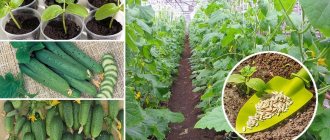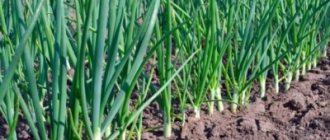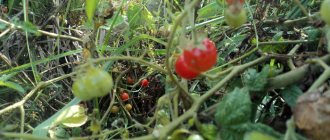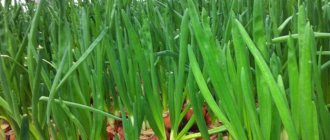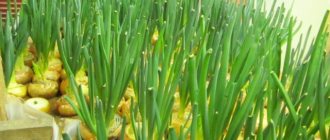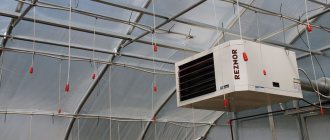Every experienced onion grower has a goal to maximize the profitability of growing green onions. One of the tasks is to find and buy the best varieties of onions. The bow on the feather must correspond to the main characteristic; it must be multi-bud or multi-lobed. In the nests of which there are several rudiments. The more rudiments there are in the onion turnip, the higher the percentage of feather yield. Which in turn increases the profitability of this business. I suggest you read the article about multi-bud onions.
Dependence of planting time on cultivation method
Planting onions on feathers should be done based on the fact that the greenery of the majority of species ripens in 2-3 weeks.
When growing plants indoors, the timing of planting does not matter, since new bulbs can be planted at any time of the year and it depends only on the need. In a greenhouse, growing onions for harvest is more justified in cold weather, due to the fact that the need for greens in winter is much greater.
The timing of planting in open ground depends on the onset of warming and warming up of the soil. This usually happens at the end of May. During the season it is possible to plant new bulbs several more times.
The time to plant onion seeds is mid-summer; in this case, greenery will begin to appear by mid-spring.
Planting in August
In order to get a rich harvest of feathers in the autumn, onions are planted in the soil in August. And if the bulbs are placed in plastic containers, feathers will appear in a short time. As soon as the air temperature begins to drop, they are moved from the street to a greenhouse or home.
The mixture for planting bulbs includes:
- humus - 2;
- soil from the garden - 1;
- peat - 7.
To get feathers in August, the following varieties are suitable: Red Baron, Bessonovsky, Shakespeare, Radar, Strigunovsky.
Site selection and soil preparation
The first step in preparing to plant onions is to choose the optimal location for the beds. This place will be a well-lit area of the site, protected from strong gusts of wind. With a lack of light, the greenery of the plant thins out and becomes pale.
It is advisable to prepare loose soil in the fall; to do this, you need to carefully dig it up, adding humus or compost in the process. It is also recommended to enrich the soil with mineral fertilizers containing nitrogen. A few days before planting begins, the soil in the beds needs to be loosened and leveled.
Collection of greens
It is difficult to say how many days it will take for your particular onion to germinate. It depends on the bulb itself and on the conditions that you create - whether there is high humidity and a greenhouse effect or not.
- If the onion was initially soaked and trimmed, then you can expect a harvest in about 17 days.
- If the bulb was initially sprouted, then the time is literally reduced to 10–14 days.
- If the conditions are not the most comfortable or the bulb has not been pruned, then the full maturation of the feather can reach 20–23 days.
In any case, it is better to focus on the length of the feather itself - as soon as it has reached 20-25 centimeters, you can safely use it in a salad.
The feathers must be cut off and not pulled out, since in this case the head can be moved out of place. It is best to use scissors or a knife.
Feathers are removed from the edges as new shoots appear in the center.
You must understand that after cutting the feather, the bulb can no longer be used to re-produce greens. You can't eat it either, so the only way out is to throw it away.
Working with planting material
To get a good harvest, you need to take a responsible approach to choosing bulbs. Their diameter should be from three to five centimeters, and their weight should be about fifteen grams. To begin with, the bulbs need to be inspected for mold, rot or damage, and also cleaned of dried scales.
The planting material must be disinfected; to do this, it must be immersed in a weak solution of potassium permanganate for 100-120 minutes. To avoid a common onion disease - downy mildew, you can warm the bulbs before planting at a temperature of forty degrees for 6-8 hours.
There is a way to grow onions faster. For such stimulation, you need to remove the top quarter of the bulb, this will facilitate the flow of oxygen into the plant. You can also collect the bulbs in a pile, water them with warm water and cover them for five days with material that will allow them to breathe but will not allow light to pass through.
These preparatory works will shorten the growth period of greenery before cutting by 5-7 days and increase the yield by sixty percent or more.
Which variety is suitable for growing at home?
Due to its prevalence, onions remain the most popular option for growing at home. But other varieties are also capable of producing a good harvest even in winter; we will list a few.
| Batun | It is also called Tatar or winter. It has excellent productivity. There are no bulbs, so it is planted in the ground. |
| Schnitt | It is distinguished by delicate and long feathers with a pleasant aroma. |
| Multi-tiered | Very unpretentious, requires virtually no maintenance. It withstands cool temperatures well, so it is in demand when grown on a windowsill. |
| Leek | There are no bulbs, the visual difference is the garlic-shaped feathers. |
| shallot | An easy-to-maintain onion that is distinguished by its high yield and ease of care. |
| Slime | Another variety that does well in cool atmospheres. It grows quickly, and the taste and smell are slightly garlicky. |
| Parade | Very tasty and even slightly fleshy leaves. |
| Rostovsky | It is not too afraid of overwatering, as it has increased resistance to fungal diseases. Gives a wonderful harvest. |
| Black Prince | Multibud - one bulb can produce many feathers. |
| Amber | It is distinguished by its dense greenery, and the bulbs themselves are not at all afraid of diseases. |
| Bessonovsky | Not the best variety for home growing - the feathers are dense and short, and the yield is average. |
Possible landing options
There are several planting options that can be seen in the photo of the bow on a feather:
Tape
A common planting option is to organize furrows in which onions are planted. The distance between the bulbs should not be less than five centimeters, and the distance between the furrows ten centimeters.
Mostovoy
When using this planting option, the bulbs are located in the garden bed as close to each other as possible. About ten kilograms of bulbs are used per square meter of bed.
The scheme for sowing onions by feather is used when growing from seeds, but this option is absolutely not practical, since you will have to wait quite a long time for the harvest.
The seeds need to be distributed very intensively along the prepared furrows, located at a distance of thirty centimeters from each other. If necessary, after the emergence of seedlings, they can be thinned out.
Egg container
Holes are made in the egg tray to drain the water, and the container is placed on a tray. For this purpose, you can use the lid of an egg tray, or a second tray that has no holes.
10-20 bulbs are planted in the recesses of the container. For this method, you can also use sets; they are planted in 2-3 pieces in one recess of the tray. In this case, the container should be filled halfway with earth.
The tray is filled with 1 cm of water, and egg trays with plantings are placed on top. You need to water through the tray. With this method there will be less rot, because the upper leaf plates remain dry.
Subtleties of seasonal care
How to care for onions after sowing or planting will greatly affect the quality and volume of the harvest. The main points of competent care are:
Weeding and loosening
Periodic loosening of the soil after watering will help maintain the required level of air exchange, and careful weeding will get rid of weeds that limit the onion's normal nutrition.
Timely watering
The watering schedule should be based on the drying of the top layer of soil. At average temperatures, watering is done several times a week. Do not allow excess moisture, as this will lead to rotting of the bulb.
Soil enrichment
It is best to use natural fertilizers when fertilizing the soil. It is more effective to combine fertilizer, which is preferably applied 3-5 times per season, with watering.
Prevention and control of diseases and insect pests
The best control option is prevention in the form of proper agricultural technology. To do this, you need to treat the soil with a solution containing soda ash and wood ash once every 7-14 days.
Ground pepper or mustard powder distributed in the garden will help against pests.
Cold protection
This process is relevant when sowing onions in winter. The bed must be covered with humus, the layer of which must be at least five centimeters. With the onset of warmth, the remaining humus should be removed. If you need to cover a bed with already sprouted greenery, you can use straw or sawdust.
cellophane plantation
For growing in a plastic bag, choose a high-density bag. The bag is filled with 10-15 cm of soil, then the bulbs are planted on the surface of the ground.
Instead of soil, you can use wet sawdust or moistened toilet paper folded in several layers. Make sure that the germination medium is not too wet, but just moist.
The bag with the planted material is tied at the top, creating the necessary microclimate inside and placed in the dark. As soon as the first sprouts appear, place the bag on the windowsill, but so that there is no draft.
As soon as the feathers rise 10 cm, the bag is untied and not tied again. Care consists of regularly moistening the soil, sawdust, paper, etc.


